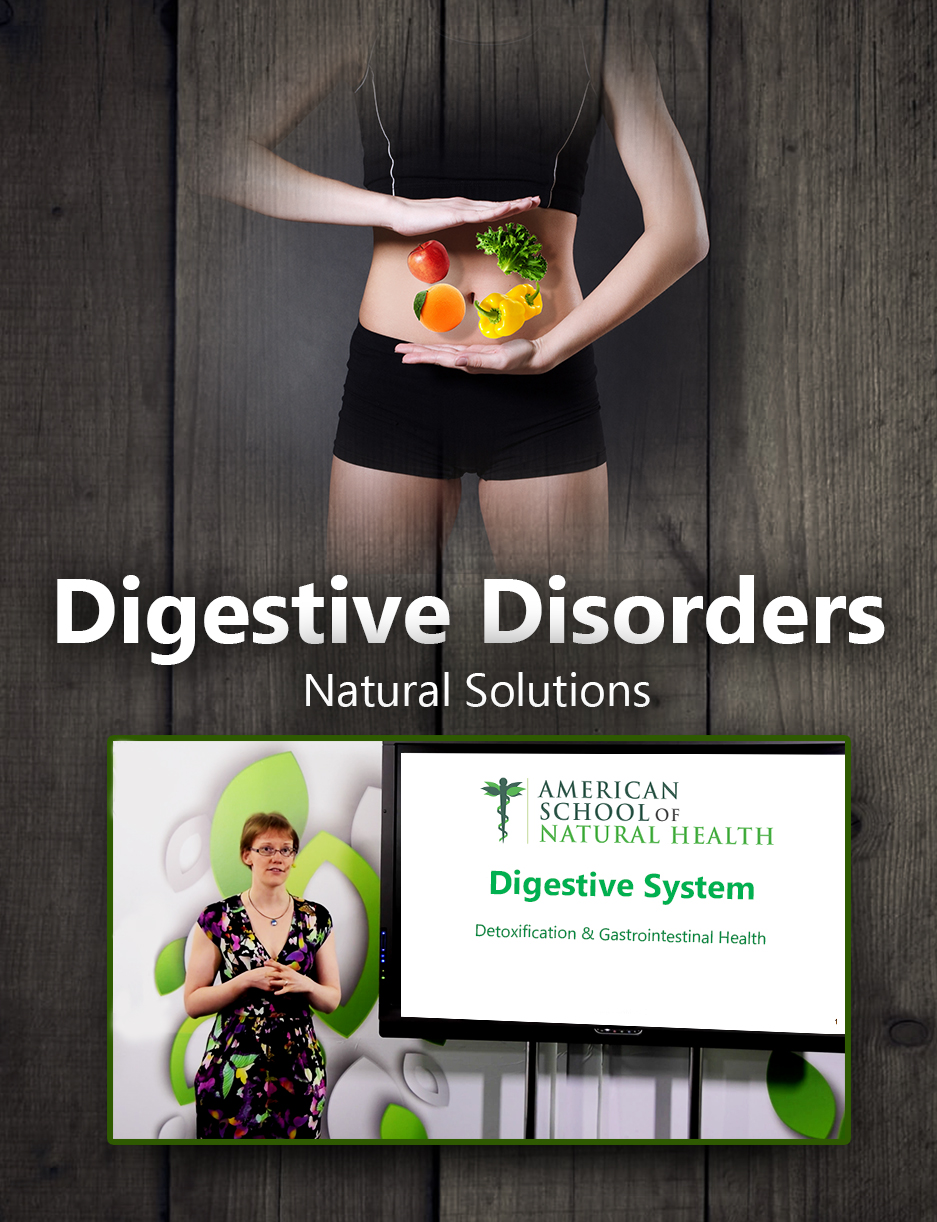
Digestive Disorders
Natural Solutions
This online course gives you an in-depth understanding of how the digestive system works. It also provides an introduction to nutrition. By the end of the course you will know what drugs are being used for digestive problems and how to use natural therapies.
Learn about:
- Diverticulitis/Crohn’s Disease
- Irritable Bowel (IBS)
- Gastritis/Acid Reflux
- Diarrhea/Constipation
- Pancreatitis/Diabetes
Tuition: $695
Length: 2-6 month
Detailed handouts
15+ hours of filmed lectures
Practice exams & exercises
(Textbooks extra at approx. $20)
Digestive Disorders Course
What you will learn:
- The structure of digestive system, function and organs, enzymes in digestion, the types of dietary carbohydrates, fats/oils and proteins as well as some of the common pathologies and how to identify and treat them.
- The concept of energy expenditure and the factors which impact on this, the factors affecting energy intake, energy expenditure and the bodily mechanisms which control food intake, sources of food toxins, possible food safety concerns including adverse reactions to food, the “farm to fork” regulations, the correct procedures for food storage and the effects of a variety of cooking techniques on nutrient content.
- The role of the gastrointestinal tract in detoxification, the scope of nutritional therapy in the support of gastrointestinal health, functions of the gastrointestinal tract as well as the importance of referral with ‘Red Flag’ symptoms.
Digestive Disorders Syllabus:
- Main organs, basic structure and main function of the digestive tract
- Mouth: anatomy and physiology: teeth, chewing and swallowing, role of the tongue, salivary glands and saliva composition/function/excretion
- Enzymes, pH
- Pharynx, oesophagus: anatomy and physiology
- Stomach: regions of the stomach, layers of the stomach walls, gastric secretions: composition and role, protective mechanisms of the stomach from “self-digestion”, stomach emptying, gastric acid secretion, roles of gastrin and CCK
- Liver and biliary system: structure of both, hepatocytes and Kupffer cells, components of bile and their function in digestion, role of the liver in: carbohydrate metabolism, protein metabolism, lipid metabolism, formation of plasma proteins, bile and bilirubin production, deamination of amino acids, storage of vitamins, detoxification, heat regulation
- Diseases of the mouth: oral thrush, mouth ulcers, diseases of the salivary glands, cleft palate, mouth cancers
- Pharynx: Tonsillitis
- Oesophagus: oesophageal varices, reflux oesophagitis
- Hiatus hernia
- Small intestine: duodenum, jejunum, ileum, digestion in the small intestine, enzymes secreted in each region and their action, relationship between duodenum and the liver, pancreas and biliary apparatus, structure of villi and microvilli, mechanisms of absorption, immune protection in the small intestine – Peyer’s patches
- Pancreas: structure of the pancreas, the pancreas as an exocrine gland, pancreatic juice – composition and function
- Large intestine: Caecum, appendix, ascending, transverse, descending and sigmoid colon, rectum and anus
- Absorption in the colon, action of microflora, formation of faeces, mechanism of egestion
- Contribution of the digestive system to homeostasis
- Stomach gastritis: acute and chronic, peptic ulceration, dumping syndrome
- Diseases of the intestines: ulceration of the duodenum (also cover oesophagus), appendicitis, dysentery/diarrhoea, irritable bowel syndrome (IBS), Crohn’s disease, ulcerative colitis, celiac disease, diverticulosis, hernias
- Diseases of the pancreas: pancreatitis
- Diseases of the liver and biliary system: Cirrhosis of the liver, cholelithiasis, ascites
-
- Energy Metabolism
- Energy intake – food sources, regulation, factors affecting
- Energy storage – means to store within the body
- Energy expenditure – factors affecting
- Life stage energy requirements
- The role of exercise in expenditure
- Control of Food Intake
- Theories of control
- Neuroscience of food intake
- Motivational states
- Energy density
- Psychosocial factors
- Regulatory Issues
- Main elements and goals in food policy
- Regulatory aspects affecting food production incl. FAO/WHO model food law
- Nutritional aspects of food policy – supply and demand; changing properties of foods e.g. fortification; international work on food policy
- Energy Metabolism
- Food Safety
- Reasons for concern regarding food safety
- Chronic effects of food borne illness
- Vulnerable groups
- Economic consequences of food borne illness
- Types and source of contamination
- Bacteria, viruses, parasites, transmissible spongiform encephalopathy’s and food
- Chemical contamination
- Possible control and prevention strategies
- Cooking and Storage Methods
- Effects of cooking on macronutrient, micronutrient, phytochemical, enzyme etc. content of food – juicing, slow cooking, baking, braising, grilling, poaching, roasting, sautéing, steaming, stir frying, microwave
- Effects of storage methods of raw and cooked on macronutrient, micronutrient, phytochemical, enzyme etc. content of food
- Definition of toxins and detoxification
- Definition of endogenous and exogenous toxins and their sources
- Symptoms of poor detoxification and the effects on body systems.
- Physiology and functions of the gastrointestinal tract
- Measures for improving detoxification
- Nature and role of gastrointestinal secretions such as HCl, Pancreatic Enzymes and Bile Acids and their key role in the overall health and immunity
- Intestinal bacteria populations, dysbiosis and use of probiotics
- Liver function and Phases 1, 2 and 3 of detoxification.
- Different types of antioxidants and their potential role in disease prevention
- Nutritional protocols for gastrointestinal health
- Common pathologies of the GIT
Certificate of Completion
After you have completed this course, you will receive a Certificate of Completion.
Short online courses are not designed or intended to qualify its participants and graduates for employment.
It is intended solely for the avocation, personal enrichment, and enjoyment of its participants.
